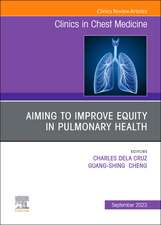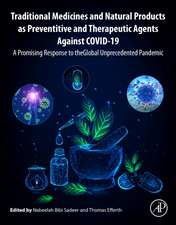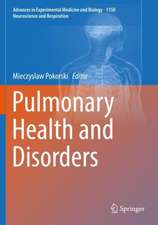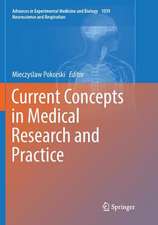The Microbiome in Respiratory Disease: Principles, Tools and Applications: Respiratory Medicine
Editat de Yvonne J. Huang, Stavros Garantziotisen Limba Engleză Paperback – 17 dec 2022
| Toate formatele și edițiile | Preț | Express |
|---|---|---|
| Paperback (1) | 711.99 lei 39-44 zile | |
| Springer International Publishing – 17 dec 2022 | 711.99 lei 39-44 zile | |
| Hardback (1) | 970.50 lei 39-44 zile | |
| Springer International Publishing – 16 dec 2021 | 970.50 lei 39-44 zile |
Din seria Respiratory Medicine
- 5%
 Preț: 910.09 lei
Preț: 910.09 lei - 5%
 Preț: 719.02 lei
Preț: 719.02 lei - 5%
 Preț: 805.89 lei
Preț: 805.89 lei - 5%
 Preț: 1111.61 lei
Preț: 1111.61 lei - 5%
 Preț: 1098.12 lei
Preț: 1098.12 lei - 5%
 Preț: 939.25 lei
Preț: 939.25 lei - 5%
 Preț: 1032.64 lei
Preț: 1032.64 lei - 5%
 Preț: 823.28 lei
Preț: 823.28 lei - 5%
 Preț: 654.11 lei
Preț: 654.11 lei - 5%
 Preț: 901.10 lei
Preț: 901.10 lei - 5%
 Preț: 719.38 lei
Preț: 719.38 lei - 5%
 Preț: 1043.97 lei
Preț: 1043.97 lei - 5%
 Preț: 778.44 lei
Preț: 778.44 lei - 5%
 Preț: 1632.41 lei
Preț: 1632.41 lei - 5%
 Preț: 718.65 lei
Preț: 718.65 lei - 5%
 Preț: 1419.39 lei
Preț: 1419.39 lei - 5%
 Preț: 781.17 lei
Preț: 781.17 lei - 5%
 Preț: 722.69 lei
Preț: 722.69 lei - 5%
 Preț: 718.46 lei
Preț: 718.46 lei - 5%
 Preț: 524.63 lei
Preț: 524.63 lei - 5%
 Preț: 1612.30 lei
Preț: 1612.30 lei - 5%
 Preț: 1101.58 lei
Preț: 1101.58 lei - 5%
 Preț: 1101.58 lei
Preț: 1101.58 lei - 5%
 Preț: 720.84 lei
Preț: 720.84 lei - 5%
 Preț: 779.16 lei
Preț: 779.16 lei - 5%
 Preț: 1417.29 lei
Preț: 1417.29 lei - 5%
 Preț: 1100.30 lei
Preț: 1100.30 lei - 5%
 Preț: 989.22 lei
Preț: 989.22 lei - 5%
 Preț: 780.45 lei
Preț: 780.45 lei - 5%
 Preț: 853.05 lei
Preț: 853.05 lei - 5%
 Preț: 1621.44 lei
Preț: 1621.44 lei - 5%
 Preț: 1042.69 lei
Preț: 1042.69 lei - 5%
 Preț: 721.77 lei
Preț: 721.77 lei - 5%
 Preț: 1601.52 lei
Preț: 1601.52 lei - 5%
 Preț: 370.21 lei
Preț: 370.21 lei - 5%
 Preț: 1108.87 lei
Preț: 1108.87 lei - 5%
 Preț: 1030.17 lei
Preț: 1030.17 lei - 5%
 Preț: 1302.37 lei
Preț: 1302.37 lei - 5%
 Preț: 1296.68 lei
Preț: 1296.68 lei - 5%
 Preț: 781.17 lei
Preț: 781.17 lei - 5%
 Preț: 1167.58 lei
Preț: 1167.58 lei - 5%
 Preț: 851.05 lei
Preț: 851.05 lei
Preț: 711.99 lei
Preț vechi: 749.47 lei
-5% Nou
136.25€ • 143.26$ • 112.57£
Carte tipărită la comandă
Livrare economică 14-19 aprilie
Specificații
ISBN-10: 3030871061
Pagini: 305
Ilustrații: XI, 305 p. 16 illus. in color.
Dimensiuni: 155 x 235 mm
Ediția:1st ed. 2022
Editura: Springer International Publishing
Colecția Humana
Seria Respiratory Medicine
Locul publicării:Cham, Switzerland
Cuprins
Notă biografică
Dr. Garantziotis is Staff Clinician, Principal Investigator and Medical Director of the Clinical Research Unit at the National Institute of Environmental Health Sciences. His research focuses on gene-environment interactions in the pathogenesis of lung disease. He is leading a number of studies on the role of the microbiome in lung injury and is the Chairperson ofthe working group “Microbiome in Lung Disease” of the American Thoracic Society, Allergy, Immunology and Inflammation Assembly.
Textul de pe ultima copertă
Caracteristici
Descriere
This book comprehensively covers the microbiome in respiratory disease, from the initial research study to the disease-specific implications and related applications. Research on the respiratory microbiome is increasing in volume and scope. This reflects rapidly growing interest in the study of respiratory disease to understand how microbiota shape mechanisms of disease pathogenesis. The respiratory tract spans the nasal passages, sinus cavities, oropharynx, and the tracheobronchial tree of the lungs. In these compartments of the upper and lower respiratory tract, the microbiota have now been studied in the context of several chronic respiratory conditions. These include chronic sinusitis, allergic rhinitis, asthma, chronic obstructive pulmonary disease (COPD), bronchiectasis and pulmonary fibrosis, to name a few. The potential impact of ecological interactions (i.e., between microbes and between microbiota and host) within and across respiratory compartments is increasingly recognized.























